| Listing 1 - 10 of 51 | << page >> |
Sort by
|
Book
Abstract | Keywords | Export | Availability | Bookmark
 Loading...
Loading...Choose an application
- Reference Manager
- EndNote
- RefWorks (Direct export to RefWorks)
"Mundell and Markusen each wrote classic papers on the relationship between trade and factor movement. Mundell showed that substitution holds in the Heckscher-Ohlin model. Markusen challenged the substitution result and showed in five different models that removing barriers to factor movement results in complementarity under free trade, identical factor endowments, and a change in any one of the other assumptions underlying the Heckscher-Ohlin model. The author generalizes Markusen's analysis by considering the liberalization of barriers to factor movement under any non-negative level of protection, and liberalizing trade barriers under factor mobility. He shows that (1) substitution holds at high protection levels, (2) complementarity holds at low protection levels, and (3) either substitution or complementarity hold under large tariff changes. "--World Bank web site.
Free trade --- Heckscher-Ohlin principle. --- Mathematical models.
Book
ISBN: 0262291703 0262272636 0585436169 9780262272636 9780585436166 9780262291705 Year: 2002 Publisher: Cambridge, Mass. MIT Press
Abstract | Keywords | Export | Availability | Bookmark
 Loading...
Loading...Choose an application
- Reference Manager
- EndNote
- RefWorks (Direct export to RefWorks)
Economists --- Heckscher-Ohlin principle. --- Heckscher-Ohlin principle --- Business & Economics --- Economic Theory --- Heckscher-Ohlin-Samuelson model --- International trade --- Comparative advantage (International trade) --- Social scientists --- Ohlin, Bertil Gotthard, --- Ohlin, Bertil,
Book
Year: 1986 Publisher: Cambridge, Mass. National Bureau of Economic Research
Abstract | Keywords | Export | Availability | Bookmark
 Loading...
Loading...Choose an application
- Reference Manager
- EndNote
- RefWorks (Direct export to RefWorks)
This paper presents conceptually correct tests of the Heckscher-Ohlin proposition that trade in commodities can be explained in terms of an interaction between factor input requirements and factor endowments. Most prior work that claims top resent tests of this hypothesis have used intuitive but inappropriate generalizations of the traditional two by two model to deal with a multidimensional reality. Moreover, prior work has in general used measurements on only two of the three variables(trade, factor input requirements and factor endowments) that are required for a proper test of the H-O theory.We derive an exact specification of the H-O interaction in a multicountry, multicommodity, multifactor world in the form of the Heckscher-Ohlin-Vanek (H-O-V) theorem which equates the factors embodied in net trade to excess factor supplies.This theorem implies sign and rank propositions analogous to those implicitly studied by Leontief, but it also implies hypotheses about the parameters linking factor contents and factor supplies. Accordingly, we conduct tests of the sign and rank propositions as well as several parametric hypotheses which permit various assumptions about measurement errors, nonproportional consumption and technological differences. Our analysis uses separately measured data on trade, factor input requirements and endowments for twenty-seven countries and twelve factors in 1967. Tests of the Leontief type sign and rank propositions sharply reject this facet of the H-O-V model. In particular, the sign of net factor exports infrequently predicts the sign of excess factor supplies and therefore does not systematically reveal factor abundance.The results from an extended set of tests conducted in a regression context reject the H-O-V hypothesis of an exact relationship between factor contents and national factor supplies. Support is found for the H-O--V assumption of homothetic preferences, but estimates of the parameters linking factor contents and factor supplies are found to differ significantly from their theoretical values. We find there is clear evidence that the departure of the estimated coefficients from their theoretical values is importantly related to differences across countries in the matrix of factor input requirements and, by implication, to violation of the assumption of factor price equalization. We also find that errors of measurement in both trade and national factor supplies are an important reason for rejection of the H-O-V hypothesis.
Input-output analysis. --- Balance of trade --- Factor analysis. --- Heckscher-Ohlin principle. --- Mathematical models.
Book
ISBN: 0262082012 9780262082013 Year: 1991 Publisher: Cambridge, Mass. MIT
Abstract | Keywords | Export | Availability | Bookmark
 Loading...
Loading...Choose an application
- Reference Manager
- EndNote
- RefWorks (Direct export to RefWorks)
Foreign trade policy --- Trade theory --- Heckscher, Eli F. --- Ohlin, Bertil --- International trade --- Foreign exchange. --- Income distribution. --- Heckscher-Ohlin principle. --- International trade.
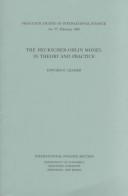
ISBN: 0881652490 Year: 1995 Publisher: Princeton International Finance Section
Abstract | Keywords | Export | Availability | Bookmark
 Loading...
Loading...Choose an application
- Reference Manager
- EndNote
- RefWorks (Direct export to RefWorks)
Comparative advantage (International trade) --- Heckscher-Ohlin principle --- 330.00 --- AA / International- internationaal --- Comparative advantage (Commerce) --- Comparative costs (International trade) --- Economische en sociale theorieën: algemeenheden --- Trade theory --- Heckscher-Ohlin-Samuelson model --- International trade --- International division of labor

ISBN: 026210086X Year: 2000 Publisher: Cambridge Mit Press
Abstract | Keywords | Export | Availability | Bookmark
 Loading...
Loading...Choose an application
- Reference Manager
- EndNote
- RefWorks (Direct export to RefWorks)
International economic relations --- Factor proportions. --- Globalization. --- Heckscher-Ohlin principle. --- Input-output analysis. --- International trade. --- Geografie --- Economische geografie --- Ontwikkeling. --- globalisation --- production --- mobilite --- facteurs de production --- politique economique --- cooperation economique --- region --- modeles economiques --- international --- International trade --- Globalization --- Input-output analysis --- Factor proportions --- Heckscher-Ohlin principle --- 382 --- Heckscher-Ohlin-Samuelson model --- Comparative advantage (International trade) --- Factor endowments --- Natural resources --- Interindustry economics --- Economics, Mathematical --- National income --- Input-output tables --- Global cities --- Globalisation --- Internationalization --- International relations --- Anti-globalization movement --- External trade --- Foreign commerce --- Foreign trade --- Global commerce --- Global trade --- Trade, International --- World trade --- Commerce --- Non-traded goods --- globalisering --- productie --- mobiliteit --- productiefactoren --- economisch beleid --- economische samenwerking --- gewest --- economische modellen --- internationaal --- Accounting
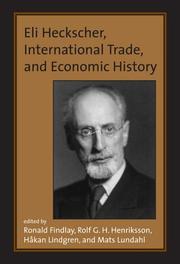
ISBN: 0262062518 9786612098178 0262272644 1282098179 1423790243 0262291932 9780262272643 9781423790242 9780262062510 9781282098176 6612098171 9780262291934 Year: 2006 Publisher: Cambridge, Mass. MIT Press
Abstract | Keywords | Export | Availability | Bookmark
 Loading...
Loading...Choose an application
- Reference Manager
- EndNote
- RefWorks (Direct export to RefWorks)
"The contributors first discuss Heckscher's efforts to forge the discipline of economic history by combining both the historian's careful evaluation of sources and the economist's rigorous models. The Heckscher-Ohlin theory of factor proportions is described and tested empirically. Contributors then apply the theory to historical material, including Mediterranean trade in Biblical times, the economic effects of two periods of plague eight centuries apart, and tariff policy in 35 countries from 1870 to 1938. Heckscher's masterly work on mercantilism, the Continental Blockade, and Swedish economic history is also described and appraised in light of recent historical research."--Jacket.
Trade theory --- Heckscher, Eli F. --- International trade --- Economic history --- Mercantile system --- Heckscher-Ohlin principle --- 382.01 --- Heckscher-Ohlin-Samuelson model --- Comparative advantage (International trade) --- Cameralism --- Kameralism --- Mercantilism --- Balance of trade --- Economic policy --- Economic conditions --- History, Economic --- Economics --- External trade --- Foreign commerce --- Foreign trade --- Global commerce --- Global trade --- Trade, International --- World trade --- Commerce --- International economic relations --- Non-traded goods --- Heckscher, Eli Filip, --- Economic history. --- Electronic books. -- local. --- Heckscher, Eli F. -- (Eli Filip), -- 1879-1952. --- Heckscher-Ohlin principle. --- International trade. --- Mercantile system. --- Business & Economics --- International Commerce --- Mercantilism (Mercantile system) --- ECONOMICS/Trade & Development --- HUMANITIES/Biography & Autobiography
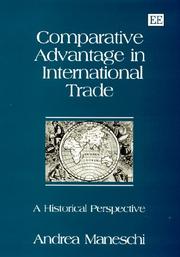
ISBN: 1858983002 Year: 1998 Publisher: Cheltenham Edward Elgar
Abstract | Keywords | Export | Availability | Bookmark
 Loading...
Loading...Choose an application
- Reference Manager
- EndNote
- RefWorks (Direct export to RefWorks)
Trade theory --- AA / International- internationaal --- 382.10 --- Theorieën van internationale en interregionale handel: algemeenheden. Comparatieve voordelen. --- Comparative advantage (International trade) --- International trade --- Comparative advantage (Commerce) --- Comparative costs (International trade) --- Econometric models --- Theorieën van internationale en interregionale handel: algemeenheden. Comparatieve voordelen --- Heckscher-Ohlin principle --- International division of labor
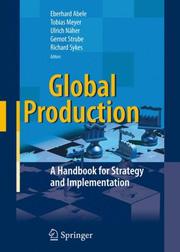
ISBN: 1281216453 9786611216450 354071653X 3540716521 Year: 2008 Publisher: Berlin : Springer,
Abstract | Keywords | Export | Availability | Bookmark
 Loading...
Loading...Choose an application
- Reference Manager
- EndNote
- RefWorks (Direct export to RefWorks)
What is the best configuration for a global production network? What are the different dynamics in low-cost vs. high-cost countries? Getting the answers right is key to building a competitive and efficient global production network. Centers of economic activity are shifting profoundly, globally and even regionally. Production is shifting even more dramatically than the economy as a whole, making it critical for decision makers to know what criteria matter most and how to make the right decisions on where to invest. Regardless of the industry involved, an optimized global footprint can translate to a competitive advantage. A comprehensive redesign typically yields a 20 to 40 percent reduction in manufacturing costs. Global production and purchasing operations create a platform for entry into new markets. Planning and implementing a sustainable globalization strategy, however, takes considerable effort; this book is there to help in that task. The wealth of experience and analysis featured in Global Production is the result of an extensive survey among leading manufacturing companies as well as countless discussions with executives who have personally wrestled with the issues of "going global." In breadth and depth, the insights it offers surpass what a manager or most individual companies could acquire on their own.
International business enterprises --- Production management. --- Comparative advantage (International trade) --- Management. --- Manufacturing management --- Industrial management --- Comparative advantage (Commerce) --- Comparative costs (International trade) --- International trade --- Heckscher-Ohlin principle --- International division of labor --- Industrial engineering. --- Operations Management. --- Industrial and Production Engineering. --- Administration --- Industrial relations --- Organization --- Management engineering --- Simplification in industry --- Engineering --- Value analysis (Cost control) --- Production engineering. --- Manufacturing engineering --- Process engineering --- Industrial engineering --- Mechanical engineering
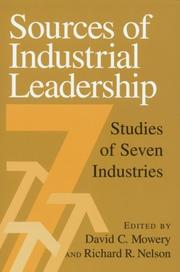
ISBN: 0521645204 052164254X 1139175122 9780521645201 9781139175128 9780521642545 Year: 1999 Publisher: Cambridge Cambridge University Press
Abstract | Keywords | Export | Availability | Bookmark
 Loading...
Loading...Choose an application
- Reference Manager
- EndNote
- RefWorks (Direct export to RefWorks)
This book describes and analyzes how seven major high-tech industries evolved in the USA, Japan, and Western Europe. The industries covered are machine tools, organic chemical products, pharmaceuticals, medical devices, computers, semiconductors, and software. In each of these industries, firms located in one or a very few countries became the clear technological and commercial leaders. In a number of cases, the locus of leadership changed, sometimes more than once, over the course of the histories studied. The focus of the book is on the key factors that supported the emergence of national leadership in each industry, and the reasons behind the shifts when they occurred. Special attention is given to the national policies which helped to create, or sustain, industrial leadership.
Industrial economics --- Economic production --- Technological innovations --- Industries --- Comparative advantage (International trade) --- Management --- Case studies --- Business, Economy and Management --- Economics --- Technological innovations - Management --- Industries - Technological innovations - Case studies --- Management. --- Comparative advantage (Commerce) --- Comparative costs (International trade) --- International trade --- Heckscher-Ohlin principle --- International division of labor --- Industrial production --- Industries, Primitive --- Industry
| Listing 1 - 10 of 51 | << page >> |
Sort by
|

 Search
Search Feedback
Feedback About UniCat
About UniCat  Help
Help News
News